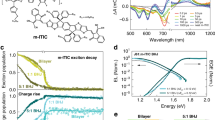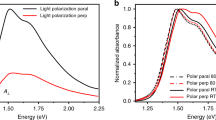Abstract
Interfaces play a crucial role in semiconductor devices, but in many device architectures they are nanostructured, disordered and buried away from the surface of the sample. Conventional optical, X-ray and photoelectron probes often fail to provide interface-specific information in such systems. Here we develop an all-optical time-resolved method to probe the local energetic landscape and electronic dynamics at such interfaces, based on the Stark effect caused by electron–hole pairs photo-generated across the interface. Using this method, we found that the electronically active sites at the polymer/fullerene interfaces in model bulk-heterojunction blends fall within the low-energy tail of the absorption spectrum. This suggests that these sites are highly ordered compared with the bulk of the polymer film, leading to large wavefunction delocalization and low site energies. We also detected a 100 fs migration of holes from higher- to lower-energy sites, consistent with these charges moving ballistically into more ordered polymer regions. This ultrafast charge motion may be key to separating electron–hole pairs into free charges against the Coulomb interaction.
This is a preview of subscription content, access via your institution
Access options
Access Nature and 54 other Nature Portfolio journals
Get Nature+, our best-value online-access subscription
$29.99 / 30 days
cancel any time
Subscribe to this journal
Receive 12 print issues and online access
$259.00 per year
only $21.58 per issue
Buy this article
- Purchase on Springer Link
- Instant access to full article PDF
Prices may be subject to local taxes which are calculated during checkout




Similar content being viewed by others
References
Agostini, G. & Lamberti, C. Characterization of Semiconductor Heterostructures and Nanostructures 2nd edn (Elsevier, 2013).
Geiger, F. M. Second harmonic generation, sum frequency generation, and χ(3): dissecting environmental interfaces with a nonlinear optical Swiss army knife. Annu. Rev. Phys. Chem. 60, 61–83 (2009).
Tang, C. W. Two-layer organic photovoltaic cell. Appl. Phys. Lett. 48, 183–185 (1986).
Halls, J. J. M. et al. Efficient photodiodes from interpenetrating polymer networks. Nature 376, 498–500 (1995).
Yu, G. & Heeger, A. J. Charge separation and photovoltaic conversion in polymer composites with internal donor/acceptor heterojunctions. J. Appl. Phys. 78, 4510–4515 (1995).
He, X. et al. Formation of nanopatterned polymer blends in photovoltaic devices. Nano Lett. 10, 1302–1307 (2010).
He, X. et al. Formation of well-ordered heterojunctions in Polymer:PCBM photovoltaic devices. Adv. Funct. Mater. 21, 139–146 (2011).
Pfadler, T. et al. Influence of interfacial area on exciton separation and polaron recombination in nanostructured bilayer all-polymer solar cells. ACS Nano 8, 12397–12409 (2014).
Bakulin, A. A. et al. The role of driving energy and delocalized states for charge separation in organic semiconductors. Science 335, 1340–1344 (2012).
Rao, A. et al. The role of spin in the kinetic control of recombination in organic photovoltaics. Nature 500, 435–439 (2013).
Gelinas, S. et al. Ultrafast long-range charge separation in organic semiconductor photovoltaic diodes. Science 343, 512–516 (2014).
Kouijzer, S. et al. Predicting morphologies of solution processed polymer:fullerene blends. J. Am. Chem. Soc. 135, 12057–12067 (2013).
Huang, Y., Kramer, E. J., Heeger, A. J. & Bazan, G. C. Bulk heterojunction solar cells: morphology and performance relationships. Chem. Rev. 114, 7006–7043 (2014).
Park, S. H. et al. Bulk heterojunction solar cells with internal quantum efficiency approaching 100%. Nat. Photon. 3, 297–302 (2009).
Banerji, N., Cowan, S., Leclerc, M., Vauthey, E. & Heeger, A. J. Exciton formation, relaxation, and decay in PCDTBT. J. Am. Chem. Soc. 132, 17459–17470 (2010).
Etzold, F. et al. Ultrafast exciton dissociation followed by nongeminate charge recombination in PCDTBT:PCBM photovoltaic blends. J. Am. Chem. Soc. 133, 9469–9479 (2011).
Provencher, F. et al. Slow geminate-charge-pair recombination dynamics at polymer:fullerene heterojunctions in efficient organic solar cells. J. Polym. Sci. B 50, 1395–1404 (2012).
Provencher, F. et al. Direct observation of ultrafast long-range charge separation at polymer–fullerene heterojunctions. Nat. Commun. 5, 4288 (2014).
Beiley, Z. M. et al. Morphology-dependent trap formation in high performance polymer bulk heterojunction solar cells. Adv. Energy Mater. 1, 954–962 (2011).
Cates Miller, N. et al. Molecular packing and solar cell performance in blends of polymers with a bisadduct fullerene. Nano Lett. 12, 1566–1570 (2012).
Cates Miller, N. et al. Factors governing intercalation of fullerenes and other small molecules between the side chains of semiconducting polymers used in solar cells. Adv. Energy Mater. 2, 1208–1217 (2012).
Cates, N. C., Gysel, R., Dahl, J. E. P., Sellinger, A. & McGehee, M. D. Effects of intercalation on the hole mobility of amorphous semiconducting polymer blends. Chem. Mater. 22, 3543–3548 (2010).
Jakowetz, A. C. et al. What controls the rate of ultrafast charge transfer and charge separation efficiency in organic photovoltaic blends. J. Am. Chem. Soc. 138, 11672–11679 (2016).
Savoie, B. M. et al. Mesoscale molecular network formation in amorphous organic materials. Proc. Natl Acad. Sci. USA 111, 10055–10060 (2014).
Savoie, B. M., Jackson, N. E., Chen, L. X., Marks, T. J. & Ratner, M. A. Mesoscopic features of charge generation in organic semiconductors. Acc. Chem. Res. 47, 3385–3394 (2014).
Cabanillas-Gonzalez, J., Grancini, G. & Lanzani, G. Pump–probe spectroscopy in organic semiconductors: monitoring fundamental processes of relevance in optoelectronics. Adv. Mater. 23, 5468–5485 (2011).
Sebastian, L., Weiser, G. & Bässler, H. Charge transfer transitions in solid tetracene and pentacene studied by electroabsorption. Chem. Phys. 61, 125–135 (1981).
Yang, Y. et al. Semiconductor interfacial carrier dynamics via photoinduced electric fields. Science 350, 1061–1065 (2015).
Scarongella, M. et al. A close look at charge generation in polymer:fullerene blends with microstructure control. J. Am. Chem. Soc. 137, 2908–2918 (2015).
De Jonghe-Risse, J. et al. Using the Stark effect to understand charge generation in organic solar cells. in Proc. SPIE Vol. 9549 (eds Hayes, S. C. & Bittner, E. R.) 95490J (2015).
Tsutsumi, J., Yamada, T. & Hasegawa, T. Electroabsorption study of charge-transfer excited state in donor-acceptor-type polymer. Trans. Mater. Res. Soc. Jpn 39, 217–219 (2014).
Sadhanala, A. et al. Preparation of single-phase films of CH3NH3 Pb(I1−xBrx)3 with sharp optical band edges. J. Phys. Chem. Lett. 5, 2501–2505 (2014).
Melzer, C., Koop, E. J., Mihailetchi, V. D. & Blom, P. W. M. Hole transport in poly(phenylene vinylene)/methanofullerene bulk-heterojunction solar cells. Adv. Funct. Mater. 14, 865–870 (2004).
Tuladhar, S. M. et al. Ambipolar charge transport in films of methanofullerene and poly(phenylenevinylene)/methanofullerene blends. Adv. Funct. Mater. 15, 1171–1182 (2005).
Mayer, A. C. et al. Bimolecular crystals of fullerenes in conjugated polymers and the implications of molecular mixing for solar cells. Adv. Funct. Mater. 19, 1173–1179 (2009).
Greiner, M. T. & Lu, Z.-H. Thin-film metal oxides in organic semiconductor devices: their electronic structures, work functions and interfaces. NPG Asia Mater. 5, e55 (2013).
Stranks, S. D. & Snaith, H. J. Metal-halide perovskites for photovoltaic and light-emitting devices. Nat. Nano 10, 391–402 (2015).
Morgenstern, F. S. F. et al. Ultrafast charge- and energy-transfer dynamics in conjugated polymer: cadmium selenide nanocrystal blends. ACS Nano 8, 1647–1654 (2014).
Böhm, M. L. et al. The influence of nanocrystal aggregates on photovoltaic performance in nanocrystal-polymer bulk heterojunction solar cells. Adv. Energy Mater. 4, 1400139 (2014).
Carey, G. H. et al. Colloidal quantum dot solar cells. Chem. Rev. 115, 12732–12763 (2015).
Mueller, C. J., Singh, C. R., Fried, M., Huettner, S. & Thelakkat, M. High bulk electron mobility diketopyrrolopyrrole copolymers with perfluorothiophene. Adv. Funct. Mater. 25, 2725–2736 (2015).
Price, M. B. et al. Hot-carrier cooling and photoinduced refractive index changes in organic–inorganic lead halide perovskites. Nat. Commun. 6, 8420 (2015).
Acknowledgements
We would like to thank S. Gélinas, N. Paul and F. Deschler for fruitful discussions. This work was supported by the Engineering and Physical Sciences Research Council (EPSRC) and the Winton Programme for the Physics of Sustainability. A.C.J. thanks the University of Cambridge for funding (CHESS). Synchrotron measurements were undertaken on the SAXS beamline at the Australian Synchrotron, Victoria, Australia and we acknowledge the help of N. Lal with the measurements. S.H. thanks the framework project Soltech for funding.
Author information
Authors and Affiliations
Contributions
A.C.J. performed the pump–push–probe measurements; M.L.B. and S.H. performed the SAXS/WAXS experiments; A.S. conducted the PDS measurement. A.C.J., M.L.B., A.S. and S.H. analysed the data. A.R. and R.H.F. supervised the work. A.C.J., A.R. and R.H.F. wrote the manuscript. All authors commented on the manuscript.
Corresponding authors
Ethics declarations
Competing interests
The authors declare no competing financial interests.
Supplementary information
Supplementary Information
Supplementary Information (PDF 1989 kb)
Rights and permissions
About this article
Cite this article
Jakowetz, A., Böhm, M., Sadhanala, A. et al. Visualizing excitations at buried heterojunctions in organic semiconductor blends. Nature Mater 16, 551–557 (2017). https://doi.org/10.1038/nmat4865
Received:
Accepted:
Published:
Issue Date:
DOI: https://doi.org/10.1038/nmat4865
This article is cited by
-
Delocalization suppresses nonradiative charge recombination in polymer solar cells
Polymer Journal (2022)
-
The role of charge recombination to triplet excitons in organic solar cells
Nature (2021)
-
Direct observation of charge separation in an organic light harvesting system by femtosecond time-resolved XPS
Nature Communications (2021)
-
Vibronic coherence contributes to photocurrent generation in organic semiconductor heterojunction diodes
Nature Communications (2020)
-
Long-lived and disorder-free charge transfer states enable endothermic charge separation in efficient non-fullerene organic solar cells
Nature Communications (2020)



